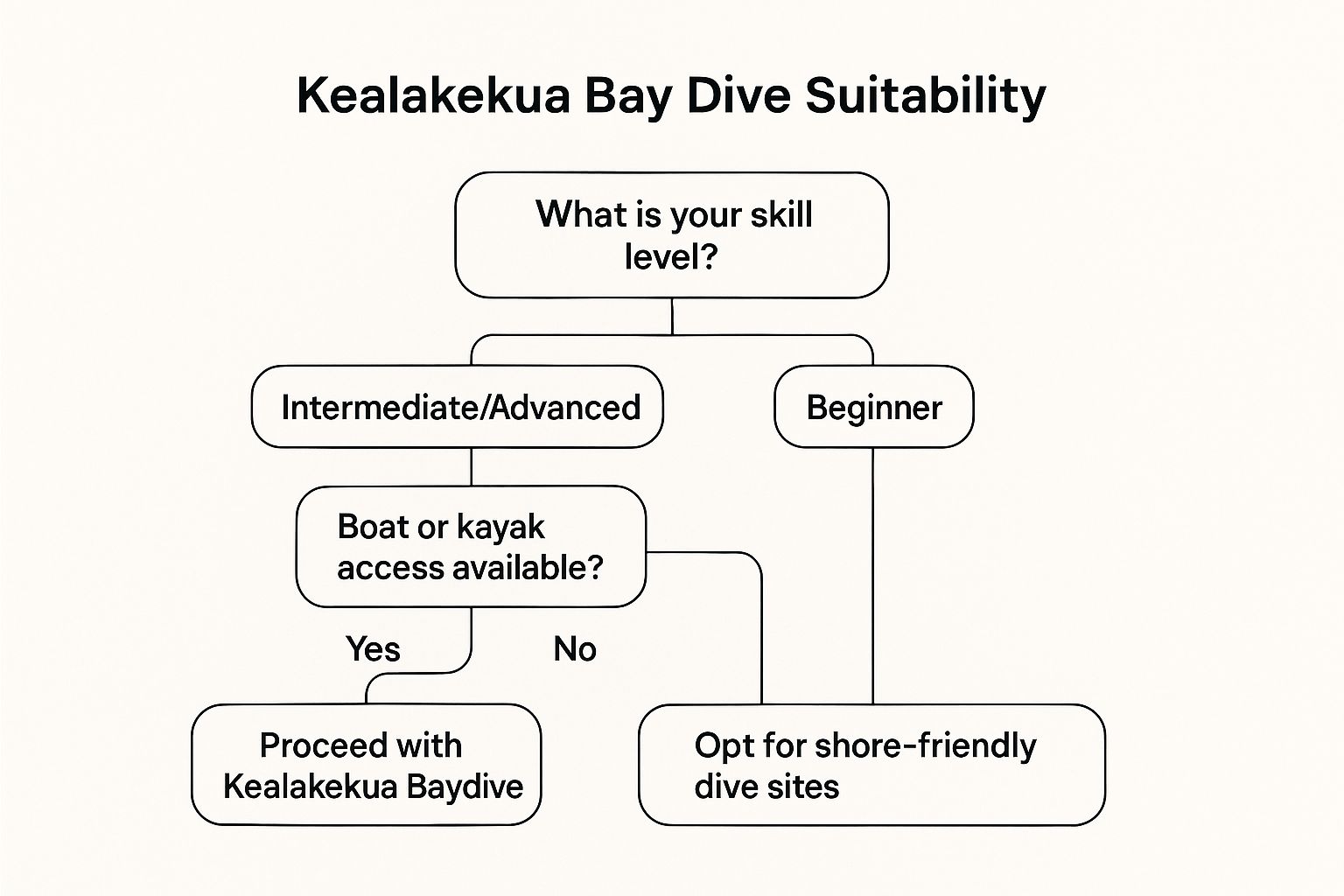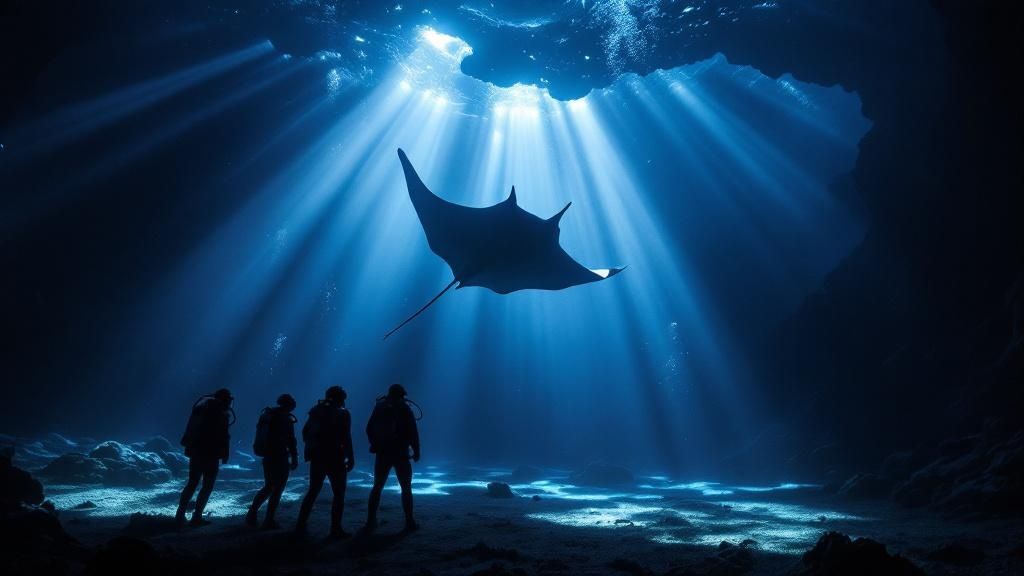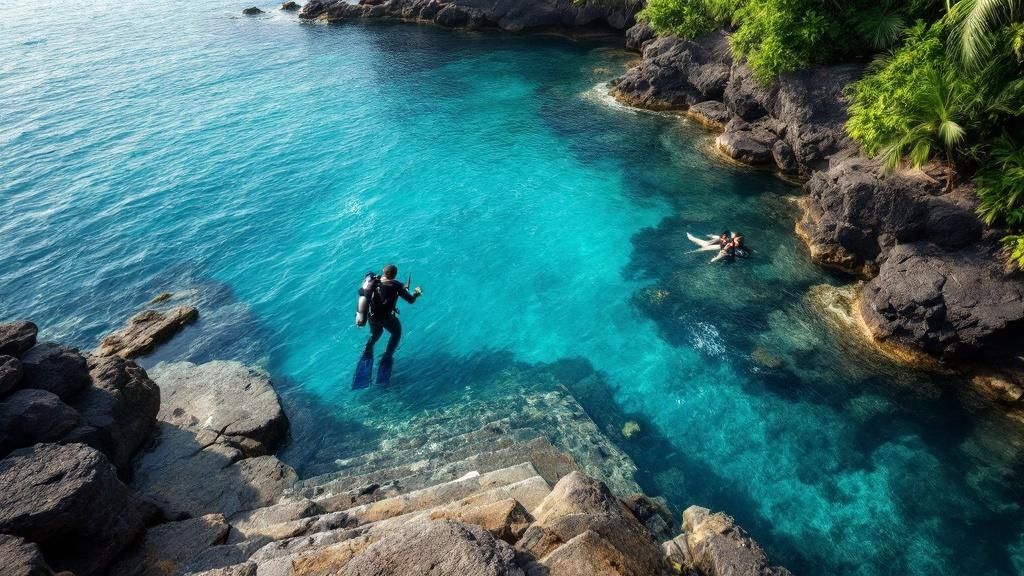Unlocking the Depths: Your Ultimate Big Island Diving Resource Guide
The volcanic coast of Hawaii's Big Island offers some of the most unique and vibrant underwater ecosystems on the planet. From world-famous manta ray encounters to exploring ancient lava tubes, planning the perfect dive trip can feel overwhelming. This guide cuts through the noise, providing a comprehensive list of essential resources for your Big Island scuba diving adventure. We'll cover the most iconic dive sites, specialized experiences like black water diving, and practical considerations for gear and certification, ensuring you're fully prepared to dive into the pristine waters of Kona and beyond. Whether you're a seasoned pro or just getting your fins wet, this is your starting point for an unforgettable underwater journey.
1. Resource #1: Premier Dive Site – Kealakekua Bay
Kealakekua Bay is not just a dive site; it's a protected marine life conservation district and a cornerstone of any premier Big Island scuba diving experience. Accessible primarily by boat or a strenuous hike, the bay’s seclusion protects its vibrant coral gardens from overuse. This results in exceptionally clear water, often with visibility exceeding 100 feet, and a thriving ecosystem teeming with spinner dolphins, green sea turtles, and vast schools of colorful reef fish.
Because it lacks easy shore access, diving here requires planning. It's an ideal destination for divers who prioritize pristine conditions and abundant marine life over convenience. The bay's calm, protected waters make it suitable for various skill levels, though boat entry is a key consideration. Dive charters like those offered by many Kona diving companies often visit this iconic location, providing the necessary transport and site-specific expertise.
The following decision tree helps determine if a Kealakekua Bay dive is right for your skill level and logistical access.

This flowchart highlights that while the dive conditions are manageable, the primary hurdle is access, making intermediate divers with boat tour arrangements the ideal candidates.
2. Resource #2: The Manta Ray Night Dive
The Manta Ray Night Dive is arguably the most famous and unforgettable Big Island scuba diving experience. This unique encounter, pioneered by operators like Jack's Diving Locker, involves submerging after sunset at designated sites off the Kona coast. Divers and snorkelers gather around a powerful underwater light source placed on the seafloor. This light attracts plankton, which in turn draws in majestic, giant Pacific manta rays to feed, creating a mesmerizing underwater ballet.

This dive isn't about exploration; it's a stationary, observational experience that is accessible to divers of various skill levels, including beginners. The key challenge is maintaining good buoyancy control in the dark while these gentle giants glide inches overhead. Operators like Kona Honu Divers and organizations such as Manta Ray Advocates promote safe, respectful interactions, ensuring the dive remains a sustainable attraction. It is a must-do for anyone scuba diving on the Big Island and offers an unparalleled connection with one of the ocean’s most graceful creatures.
To ensure a successful and respectful manta ray dive, consider the following checklist. This guide helps you prepare for the specific conditions and etiquette of this world-renowned night dive.
The checklist emphasizes that preparation, particularly buoyancy skills and choosing a responsible operator, is critical to both your enjoyment and the well-being of the mantas.
3. Two Step (Honaunau Bay)
For divers seeking the ultimate in accessibility and convenience, Two Step, also known as Honaunau Bay, is a premier shore diving destination. Located adjacent to the Pu'uhonua o Honaunau National Historical Park, its name comes from the two natural lava rock steps that provide an exceptionally easy entry and exit point into the calm, protected waters. This makes it a standout location for Big Island scuba diving, especially for beginners and those completing certifications.

The bay's protected status ensures a flourishing reef with abundant marine life, including green sea turtles, eels, and large schools of reef fish, often in shallow depths perfect for long, relaxed dives. Its straightforward logistics and consistently good conditions make it a favorite for local dive shops and training agencies. However, its popularity means parking can be limited, so an early morning arrival is highly recommended. For those looking for a comprehensive overview of the best shore diving on the Big Island, Two Step consistently ranks at the top for its blend of easy access and vibrant underwater scenery.
4. Cathedrals I & II (Off Lanai)
While technically off the coast of Lanai, Cathedrals I & II are often included in advanced Big Island scuba diving itineraries, accessible via specialized boat charters. These are not buildings but immense underwater lava tubes with collapsed ceilings, allowing sunlight to filter down and create a stained-glass, cathedral-like effect. The dramatic topography, featuring large caverns, swim-throughs, and arches, makes this a pinnacle dive for underwater photographers and thrill-seekers.
Because of the overhead environment and depth, these sites are exclusively for advanced divers. Navigating the dark caverns requires skill, confidence, and proper equipment. Companies offering trips here, like Trilogy Excursions, cater to experienced divers comfortable with more demanding conditions. The sites are teeming with unique life, including frogfish, nudibranchs, and reef sharks that patrol the cavern entrances, offering a different ecosystem from typical Kona dives.
These sites are ideal for those who have mastered buoyancy and want a unique geological dive. Key considerations are:
- Certification: Advanced Open Water is a minimum requirement.
- Equipment: Redundant light sources are essential, not optional.
- Mindset: You must be comfortable in enclosed underwater spaces.
Diving Cathedrals I & II provides a memorable adventure for those seeking to push their skills and witness one of Hawaii's most awe-inspiring underwater landscapes.
5. Black Water Diving
For the ultimate adventure in Big Island scuba diving, black water diving offers a truly unique pelagic experience. Conducted at night in deep open ocean waters, divers drift tethered to a weighted line suspended from a boat. This innovative dive intercepts the largest daily vertical migration on Earth, where deep-sea organisms ascend toward the surface to feed under the cover of darkness. Divers can witness an otherworldly parade of bioluminescent and often transparent creatures, many of which are larval stages of familiar reef dwellers or are otherwise rarely seen by humans.
This is an advanced dive that requires a high degree of comfort in the water and excellent buoyancy control. Because you are suspended in the black abyss, it is not for the faint of heart, but the rewards are unparalleled. Pioneered commercially in Kona, this type of dive has attracted marine biologists and photographers from institutions like National Geographic. To get a glimpse into this alien world, see the video below.
Due to its specialized nature, this dive must be booked well in advance with an experienced operator. You can explore a detailed guide to this cutting-edge experience and learn more about black water diving on konahonudivers.com.
6. Puako Reef
Puako Reef is an expansive fringing coral system along the Kohala Coast, offering some of the healthiest and most vibrant coral formations for Big Island scuba diving. Known for its relatively easy shore access, this area provides a different experience from the boat-centric dives of Kona. The reef stretches for miles, featuring shallow coral gardens perfect for beginners and deeper, intricate caverns and archways that appeal to more advanced divers. This diversity makes it a key site for both recreation and marine research.
Because it is accessible from shore, preparation is crucial. Divers must navigate rocky entries, making sturdy dive boots a necessity. The area is a labyrinth of coral fingers and sand channels, so understanding your entry and exit points is vital for a safe dive. Its status as a popular spot for local divers and its use in eco-tourism initiatives highlight its importance to the island's marine ecosystem. For divers looking for more shore diving guidance, reviewing some essential dive travel tips can greatly improve the experience.
This flowchart helps illustrate who is best suited for a shore dive at Puako Reef based on their preparation and experience.
The flowchart emphasizes that while accessible, Puako rewards divers who are self-sufficient and well-prepared for shore entry conditions.
7. Lava Tube Diving
For those with advanced training, Big Island scuba diving offers a rare opportunity to explore underwater lava tubes, ancient conduits formed by volcanic flows. These submerged caverns and swim-throughs create a surreal, almost otherworldly diving environment. Exploring these geological wonders requires specialized skills and equipment, as divers navigate overhead environments where direct ascent to the surface is not always possible. This type of diving is reserved for those who have completed cavern or cave diving certifications.
Due to the inherent risks, this activity is not for the casual diver. Proper training in line-laying, buoyancy control in enclosed spaces, and emergency procedures is mandatory. You must always dive with multiple light sources and a certified guide experienced with the specific tube system. Dive operators that offer these trips are highly specialized and often integrate them into advanced or technical diving courses. To ensure you select a professional and efficient operator, it can be insightful to explore the various business solutions available for Scuba Diving Business Solutions that streamline their operations. Most of these sites are accessible via a short boat ride, a key consideration detailed when comparing boat vs shore diving options.
Top 7 Big Island Scuba Dive Sites Comparison
| Dive Site / Experience | Core Features & Highlights | User Experience & Quality ★ | Target Audience 👥 | Unique Selling Points ✨ | Price & Value 💰 |
|---|---|---|---|---|---|
| Kealakekua Bay | Marine sanctuary, 100+ ft visibility, dolphins | ★★★★★ Exceptional clarity, protected habitat | Intermediate/Advanced divers, photographers | Historic site, pristine coral, high visibility | Medium (boat access needed)💰💰 |
| Manta Ray Night Dive | Year-round manta sightings, shallow night dive | ★★★★★ High success rate (95%), unforgettable wildlife | Newer & experienced divers, night dive certified | Iconic manta encounters, shallow, year-round | Higher cost, guided only 💰💰💰 |
| Two Step (Honaunau Bay) | Shore entry, protected bay, easy access | ★★★★ Good visibility, beginner-friendly | Beginners, families, certification courses | Free shore access, easy lava rock entry | Best value (shore dive, free access) 💰 |
| Cathedrals I & II | Lava tube formations, swim-through caverns | ★★★★ Spectacular architecture, less crowded | Advanced, technical divers, photographers | Dramatic lava swim-throughs, challenging dive | Higher price (boat, advanced skills) 💰💰 |
| Black Water Diving | Deep pelagic night dive, vertical migration | ★★★★★ Unique deep-sea creatures, scientific | Advanced night divers, researchers | Rare species, cutting-edge experience | Premium pricing, specialized gear 💰💰💰 |
| Puako Reef | Extensive coral reef, diverse marine life | ★★★★ Healthy coral, year-round good visibility | Coral lovers, marine biology students, intermediates | Protected reef, cultural significance | Medium value, shore & boat options 💰💰 |
| Lava Tube Diving | Volcanic formations, cavern environment | ★★★★ Educational, unique geology | Technical/advanced divers, geology enthusiasts | Volcanic tubes, overhead environment | Premium (certifications needed) 💰💰 |
Frequently Asked Questions About Big Island Diving
As we've explored, the world of Big Island scuba diving offers a truly unparalleled spectrum of underwater adventures. From the ethereal Manta Ray Night Dive and the abyssal wonders of a Black Water Dive to the vibrant coral gardens of Puako Reef and the unique geology of lava tubes, the Kona coast is a premier global diving destination. You now have the essential information on top-tier dive sites, respected charter companies like Kona Honu Divers, and what makes this island a must-visit for any certified diver. Mastering this knowledge transforms a good vacation into an extraordinary one, ensuring your dives are safe, memorable, and perfectly matched to your skill level.
The key takeaway is that planning is paramount. Understanding the nuances between dive operators, knowing the best seasons, and selecting sites that align with your interests will maximize your time in the water. This preparation allows you to fully immerse yourself in the incredible biodiversity and volcanic seascapes that make diving Hawaii Big Island so special. Your next step is to choose your ideal dive experiences and book with a trusted operator who prioritizes safety and a premium, diver-focused adventure.
Is there good diving on the Big Island?
Yes, the Big Island offers some of the best and most diverse diving in Hawaii. Its volcanic underwater topography creates unique lava tubes, arches, and caverns. It is world-famous for its reliable Manta Ray Night Dive and pioneering Black Water Dives, alongside dozens of healthy coral reefs teeming with endemic species.
What are the best months to scuba dive in Hawaii?
While you can dive year-round, the best conditions are typically during the summer months (May to October) when the water is calmest and warmest. Winter (November to April) can bring larger swells, particularly on north-facing shores, but also offers the chance to hear humpback whales singing underwater.
Is Kona good for scuba diving?
Kona is exceptional for scuba diving. The western coast is shielded from prevailing trade winds, resulting in consistently calm and clear conditions. This makes Kona diving accessible almost every day of the year and home to the island's most famous dive sites, including Kealakekua Bay and the manta ray sites.
Is it better to snorkel or scuba dive in Hawaii?
It depends on your comfort level and what you want to see. Snorkeling is fantastic for viewing shallow reefs and is accessible to everyone. However, scuba diving Big Island allows you to explore deeper, see different marine life like garden eels and sharks, navigate lava tubes, and have more intimate, extended encounters with animals like manta rays. For non-diving family members, a dedicated operator like Kona Snorkel Trips is an excellent choice.
Which Hawaiian island is best for scuba diving?
The Big Island, specifically the Kona coast, is widely considered the best for its diversity, accessibility, and unique signature dives like the manta and blackwater experiences. While Maui and Oahu have great sites, the scuba Big Island scene offers a range of underwater environments that is hard to match.
When to dive Kona?
You can dive Kona year-round due to its calm, protected waters. Summer offers the warmest water and flattest seas. Winter brings slightly cooler water but also the awe-inspiring soundtrack of migrating humpback whales, making any time of year a fantastic time for diving Big Island.
Ready to experience the best scuba diving the Big Island has to offer? For an award-winning, diver-centric experience, book your next underwater adventure with the top-rated team at Kona Honu Divers. Their focus on small groups and diver-only boats ensures you get the premium experience you deserve.
